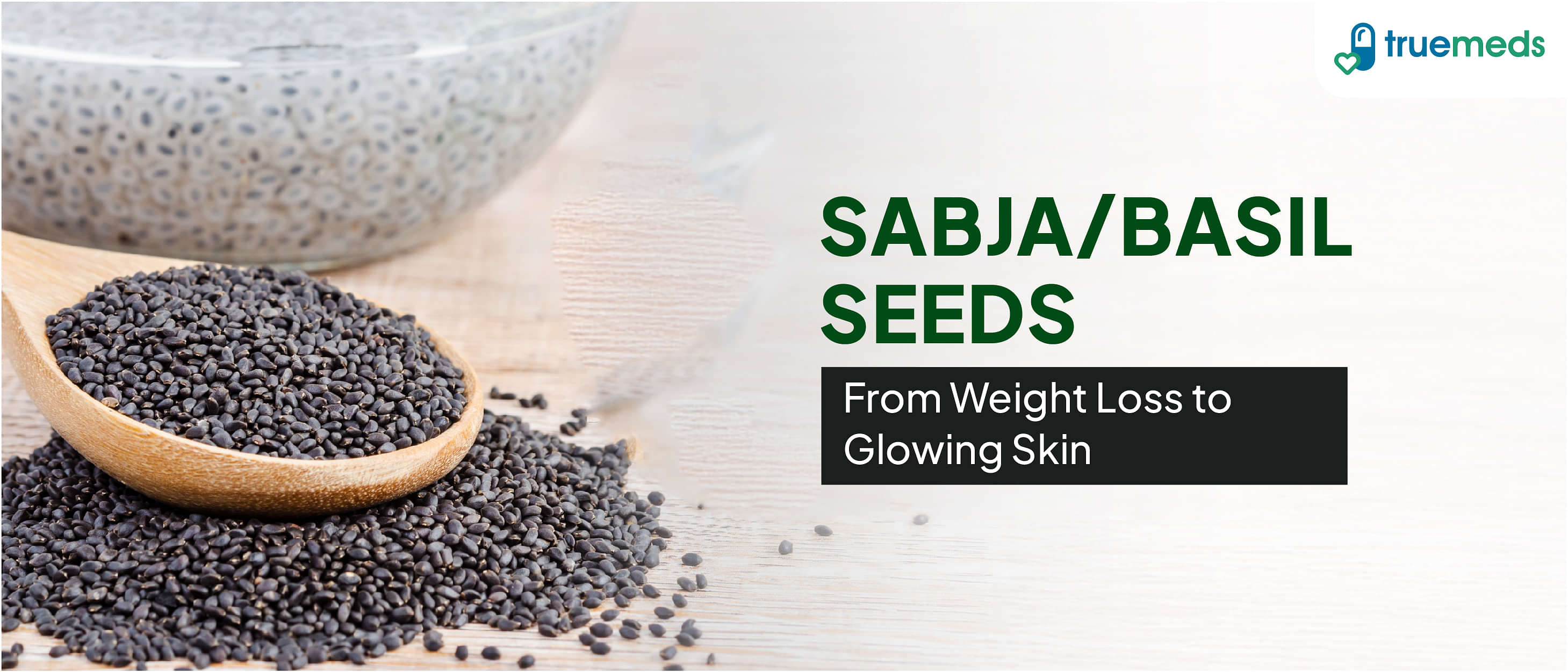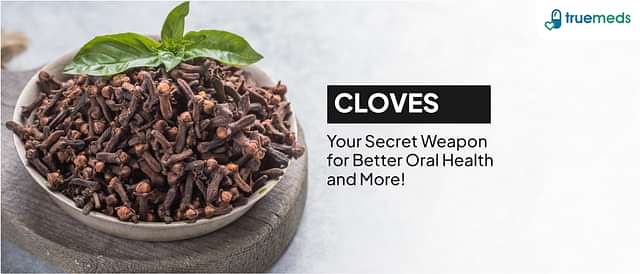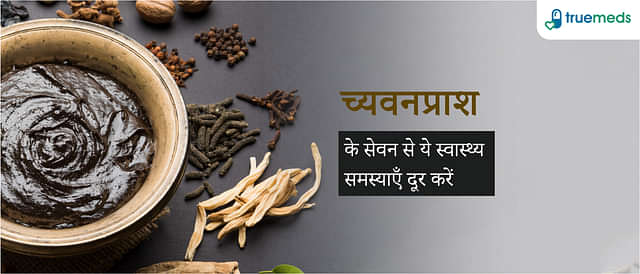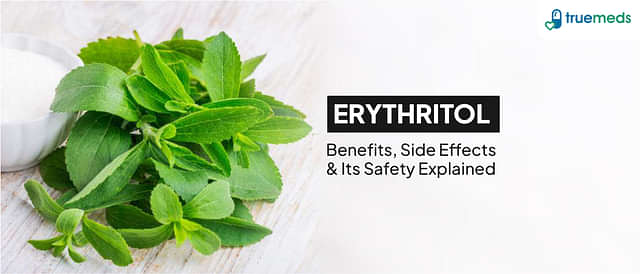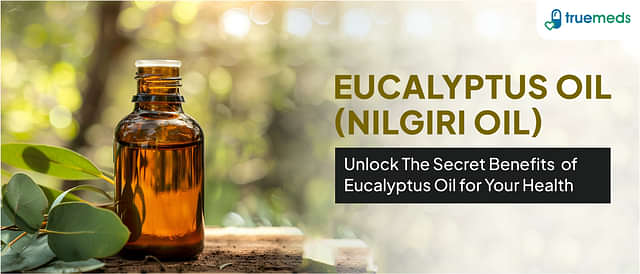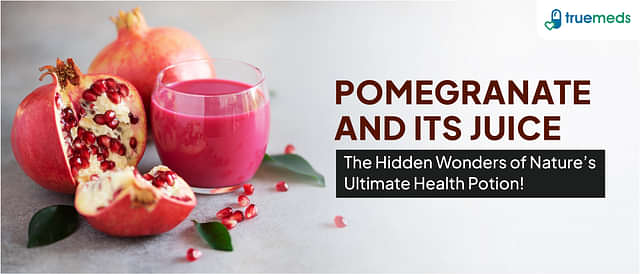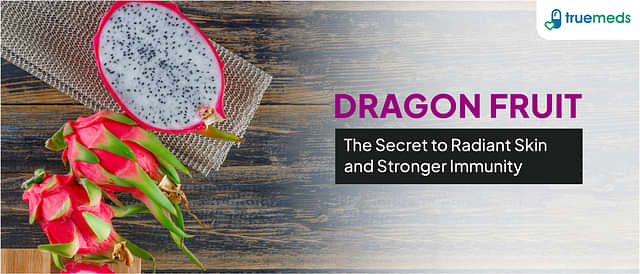Health Benefits of Sabja (Basil) Seeds in Your Daily Life
Last updated on : 03 Jan, 2025
Read time : 10 min
Introduction
Sabja seeds in english are known as basil seeds. It has gained significant popularity recently due to their rich nutrient profile and potential health advantages. These seeds contain essential vitamins, minerals, and antioxidants, naturally boosting overall well-being.
The benefits of sabja seeds are not limited to their nutritional value alone. These seeds have been utilised for centuries in traditional medicine practices due to their potential medicinal properties.
This blog aims to bridge the gap between ancient wisdom and modern understanding, exploring the science behind these seeds and their impact on our health. It will also explore the numerous benefits of basil seeds, ranging from their potential role in digestion and weight management to their antioxidant and anti-inflammatory properties.
Nutritional value of sabja seeds
Sabja seeds are low in calories and fat, making them a great addition to a balanced diet. They are also a good source of dietary fibre, which aids in digestion and helps maintain bowel regularity. Sabja seeds are rich in calcium, iron, magnesium, and phosphorus, contributing to bone health, muscle function, and overall well-being.
The benefits of sabja seeds also contain essential vitamins such as A, C, E, and K, which support various bodily functions and provide antioxidant benefits.
Basil seeds nutrition facts 100g
Here is the nutritional profile of the basil/sabja seeds
| Nutrient | Amount per 100 g |
| Carbohydrates | 47.8 g |
| Fibre | 37.7 g |
| Protein | 23 g |
| Fat | 4.07 g |
| Calcium | 2240 mg |
| Iron | 89.8 mg |
| Magnesium | 711 mg |
| Phosphorus | 274 mg |
| Potassium | 2630 mg |
| Vitamin A | 744 International units (IU) |
| Vitamin C | 0.8 mg |
| Vitamin E | 10.7 mg |
| Vitamin K | 1710 µg |
Basil/Sabja Seeds Benefits
Some common side effects of sabja/basil seeds are:
1. Antioxidant/anti-ageing effect
Numerous research studies have provided evidence supporting the antioxidant properties of sabja seeds. In addition to their antioxidant potential, sabja seeds are also known to be rich in total phenols. These bioactive compounds have demonstrated their effectiveness in combating serious diseases like cancer and cardiovascular disease.
2. Antimicrobial effect
With the rise of drug-resistant bacteria, scientists have been exploring the antibiotic properties of sweet basil seeds. Studies have revealed that sabja seeds are effective against gram-negative and gram-positive bacteria. It is due to the mucilaginous coatings’ antimicrobial action in the seeds.
3. Anti-inflammatory effect
Sabja seeds contain anti-inflammatory compounds that can help reduce inflammation in the body, potentially relieving symptoms of inflammatory conditions such as arthritis and promoting overall well-being.
4. Weight loss
The benefits of sabja seeds include weight loss, as they are low in calories and high in fibre, which can promote a feeling of fullness, aid digestion, and help control appetite.
5. Skincare
Antioxidants and essential nutrients in sabja seeds contribute to healthier skin by promoting cell regeneration, reducing inflammation, and improving skin elasticity.
6. Reduces blood sugar levels
Sabja seeds have been found to have hypoglycemic effects, helping to regulate blood sugar levels and potentially benefiting individuals with diabetes.
7. Relieves constipation
The fibre content in sabja seeds can help promote bowel regularity, prevent constipation, and improve digestive health.
8. Powerhouse of minerals
Sabja seeds are a good source of essential minerals like calcium, magnesium, and iron, which are vital for maintaining healthy bones, muscle function, and overall well-being.
9. Prevents the risk of heart diseases
The fibre and omega-3 fatty acids in sabja seeds contribute to heart health by reducing cholesterol levels, improving lipid profiles, and supporting cardiovascular function.
10. Good for oral health
Chewing sabja seeds may help improve oral health by promoting saliva production, which can neutralise acids and prevent tooth decay.
11. Reduce cholesterol levels
Regular consumption of sabja seeds may help lower LDL (bad) cholesterol and raise HDL (good) cholesterol levels, reducing the risk of cardiovascular diseases.
12. Good for hair growth
The essential nutrients in sabja seeds, including vitamins, minerals, and proteins, promote healthy hair growth, strengthen hair follicles, and reduce hair fall.
13. Other uses of sabja or basil seeds
Other benefits of basil seeds include making refreshing drinks and desserts and adding to salads, yoghurts, and smoothies, enhancing the taste and nutritional value of various dishes.
Chia seeds and sabja seeds
While chia seeds and sabja seeds share some similarities, such as their use in weight loss and high fibre content, it’s important to note that they are not the same. Each seed has unique characteristics, nutritional profiles, and potential health benefits. Therefore, it’s crucial to understand the differences between sabja seeds and chia seeds before incorporating them into your diet or wellness routine.
Difference between chia seeds and sabja seeds
| Characteristics | Sabja seeds | Chia seeds |
| Origin | Native to India | Native to Mexico/ Central America |
| Appearance | Small, round-shaped seeds | Small, oval-shaped seeds |
| Colour | Black or dark brown | Various shades of brown |
| Water Absorption | Spontaneously swell | Takes time to swell |
| Taste | Fragrant flavour | Bland |
| Touch/Texture | The gluey feeling upon chewing | Soft when chewed |
| Nutritional Value | Good source of fibre, carbohydrates, and minerals | Good source of omega-3 fatty acids, fibre, protein, and antioxidants |
| Culinary use | Used in falooda, beverages, and desserts | Added to smoothies, baked goods, and yoghurt |
| Medicinal benefits | Known for cooling properties, aids digestion and may help reduce body heat | It may aid in weight loss, promote digestive health, and provide energy |
| Availability | Commonly found in Indian grocery stores and online | Widely available in stores and online |
Sabja seeds are commonly known by a variety of names like:
- Basil seeds
- Tukmaria seeds
- Falooda seeds
- Sweet basil seeds
Side effects of sabja seeds
While the benefits of sabja seeds are numerous, they also come with potential side effects, which include:
- Nausea: Some individuals may experience nausea after consuming basil seeds.
- Vomiting: Sometimes, consuming sabja seeds may lead to vomiting.
- Acne: It has been reported that specific individuals may experience acne breakouts.
- Acid reflux: Sabja seeds sometimes contribute to acid reflux or heartburn symptoms.
- Headache: Certain individuals may experience headaches as a side effect.
- Lowered blood sugar: Basil seeds have the potential to lower blood sugar, which can be a concern for individuals with diabetes or those taking medications to control blood sugar.
- Loss of appetite: Some individuals may experience a decrease in appetite.
Precautions while consuming sabja seeds
Following precautions must be taken for sabja seeds
- Not appropriate for pregnant women: Pregnant women should avoid consuming sabja seeds as they can increase estrogen levels, which may not be advisable during pregnancy.
- Caution for children: Keeping Sabja seeds away from children is essential as they pose a choking hazard.
Conclusion
While sabja seeds are not a magical cure-all, they offer a range of health benefits worth considering. Their high nutrient content and traditional medicinal uses make them a promising addition to one’s diet.
However, it is essential to remember that more research is required to fully understand their benefits and potential side effects and determine the most effective ways to incorporate them into our diets. Incorporating sabja seeds into a balanced diet may be a simple and effective way to support overall well-being.
You can download our user-friendly Truemeds app for easy access to medicine at low rates. Submit your prescription to our platform to receive branded and generic medications. Enjoy savings on purchases and the added convenience of free home delivery on relevant orders across India*.
Frequently asked questions
Pregnant women and children should avoid consuming sabja seeds. The increase in estrogen levels caused by sabja seeds can be potentially harmful to pregnant women, and children may risk choking due to the seeds’ small size and gel-like texture.
Sabja seeds have anti-inflammatory properties, which may help reduce joint pain and inflammation. However, more research is needed to establish their specific effectiveness in alleviating joint pain.
The recommended method of consuming sabja seeds is by soaking them in water. It allows the seeds to swell and form a gel-like consistency. The soaked seeds can be added to various beverages, such as lemonade or milkshakes, or used as a topping for desserts and puddings.
It is not necessary to soak sabja seeds overnight. They can be soaked in water for 15 to 30 minutes until they swell up and become gelatinous. However, you can soak them longer if you prefer a softer texture.
Sabja water can be consumed at any time during the day. Some people prefer to consume it in the morning on an empty stomach, while others may enjoy it as a refreshing drink throughout the day. Choose a time that works best for you and fits into your daily routine.
Limited scientific evidence suggests that sabja seeds impact menstrual cycle timing. While some traditional practices claim that sabja seeds can regulate menstrual cycles, more research is needed to validate these claims. It is always advisable to consult with a healthcare professional for personalised advice regarding menstrual health.
By incorporating them into your diet, sabja seeds can be used for weight loss. One popular method is to soak the seeds in water for 15 to 30 minutes until they swell up and form a gel-like consistency. You can then add the soaked seeds to beverages like lemonade or smoothies or use them as a topping for salads and yoghurts.
The recommended daily intake of basil seeds, or sabja seeds, is 1 to 2 tablespoons. However, it’s important to note that individual needs may vary, and it’s best to consult with a healthcare professional or nutritionist for personalised advice.
Disclaimer
The content provided within this article has been thoroughly verified for accuracy. However, we advise consulting a healthcare professional before utilising any medication or dietary supplements mentioned herein.
References
- Calderón Bravo H, Vera Céspedes N, Zura-Bravo L, Muñoz LA. Basil seeds as a novel food, source of nutrients and functional ingredients with beneficial properties: A review. Foods. 2021 Jun 24;10(7):1467. [Cited on 2023 July 12]. Available from: https://www.ncbi.nlm.nih.gov/pmc/articles/PMC8303141
- Vlaicu PA, Untea AE, Turcu RP, Saracila M, Panaite TD, Cornescu GM. Nutritional composition and bioactive compounds of basil, thyme and sage plant additives and their functionality on broiler thigh meat quality. Foods. 2022 Apr 12;11(8):1105. [Cited on 2023 July 12]. Available from: https://www.ncbi.nlm.nih.gov/pmc/articles/PMC9029320/
- Takeuchi H, Takahashi-Muto C, Nagase M, Kassai M, Tanaka-Yachi R, Kiyose C. Anti-inflammatory effects of extracts of sweet basil (Ocimum basilicum L.) on a co-culture of 3T3-L1 adipocytes and RAW264. 7 macrophages. Journal of oleo science. 2020;69(5):487-93. [Cited on 2023 July 12]. Available from: https://pubmed.ncbi.nlm.nih.gov/32281564/
- Bensaid A, Boudard F, Servent A, Morel S, Portet K, Guzman C, Vitou M, Bichon F, Poucheret P. Differential nutrition-health properties of Ocimum basilicum leaf and stem extracts. Foods. 2022 Jun 9;11(12):1699. [Cited on 2023 July 12]. Available from: https://www.ncbi.nlm.nih.gov/pmc/articles/PMC9222536/
Disclaimer
Our healthcare experts have carefully reviewed and compiled the information presented here to ensure accuracy and trustworthiness. It is important to note that this information serves as a general overview of the topic and is for informational purposes only. It is not intended to diagnose, prevent, or cure any health problem. This page does not establish a doctor-patient relationship, nor does it replace the advice or consultation of a registered medical practitioner. We recommend seeking guidance from your registered medical practitioner for any questions or concerns regarding your medical condition.
Popular Articles
Recommended Articles
Recent Articles
Top-Selling Medicines:
...View more
Top-Selling OTC:
...View more
Company
About UsHealth ArticleHealth StoriesDiseases & Health ConditionsAll MedicinesAll BrandsNeed HelpFAQSubscribe
Registered Office Address
Grievance Officer
Download Truemeds

Contact Us
Our customer representative team is available 7 days a week from 9 am - 9 pm.
v3.7.10
Our Payment Partners









